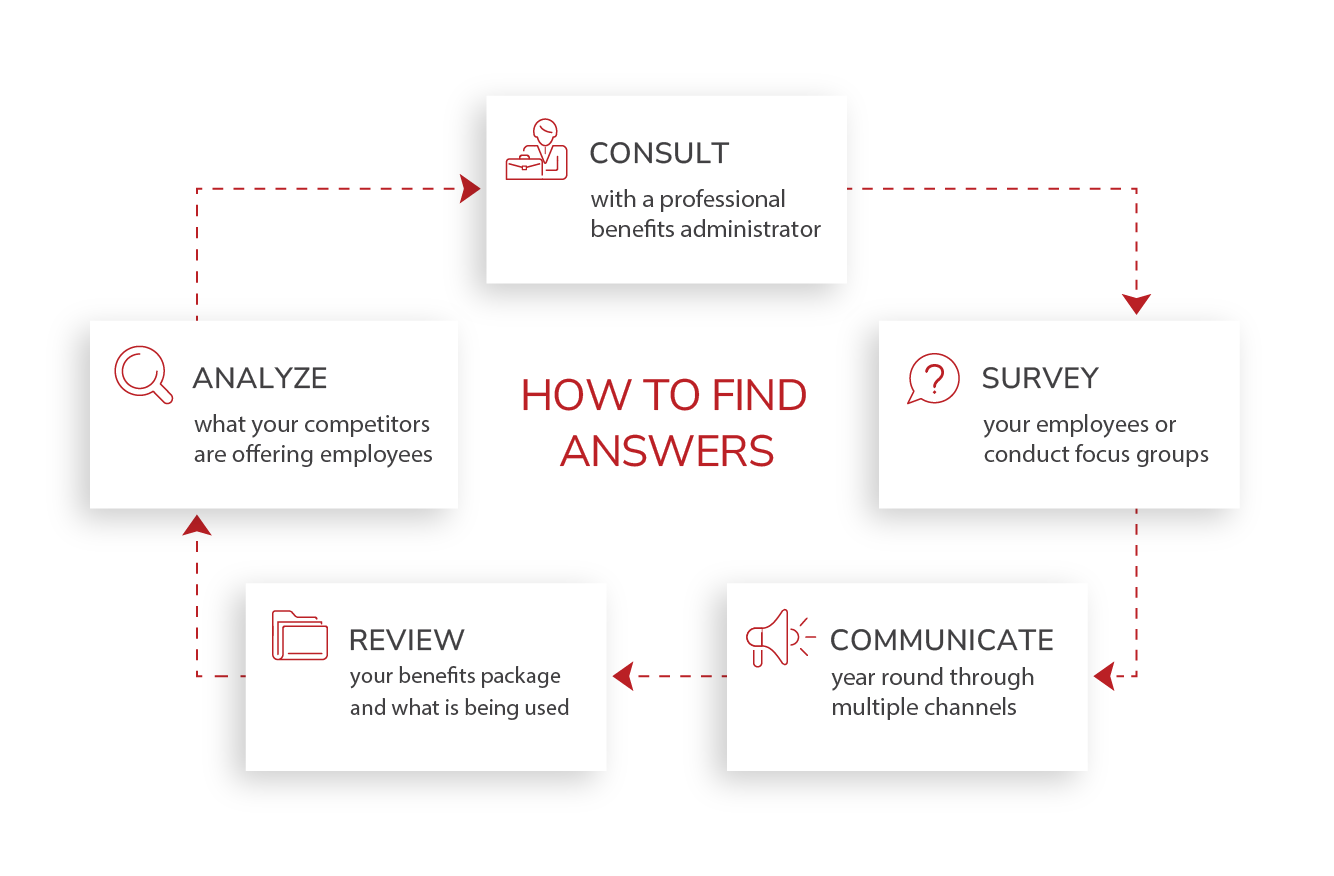Questions to Kick-Start Your Benefits Strategy Planning in 2025
Is your benefits strategy contributing to your growth or quietly draining your resources? Being more strategic with your benefits program can seem overwhelming at first, but if you know the right questions to ask and do an honest assessment of your current benefits package, you can start to develop a benefits strategy that strengthens your business.

Despite the important role employee benefits play in driving retention and engagement, too often companies see benefits as a checkbox expense rather than an instrument for profitability. If you’re not sure whether your benefits strategy is pulling its weight, the new year is the perfect time to take a closer look and start thinking about how to make your employee benefits program work for you.
In This Article
Crafting a benefits strategy that truly aligns with employee needs and business goals starts with asking yourself the right questions. By taking a curious, proactive approach, you can uncover gaps in your offering, highlight opportunities to boost the value of your benefits, and lay a strong foundation for a performance-driven benefits plan.

Once you begin, you’ll find that one question usually leads to another. And, that’s a good thing. As you dive deep into benefits planning, let the questions (and answers) shape a stronger, smarter strategy that grows with your company.
1. Are our benefits aligned with what our employees actually want?
Offering benefits that miss the mark or go unused is, simply, a waste of your time and money. To drive satisfaction and engagement, your benefits need to reflect what employees actually want and need. So, do you know what your employees actually want? When was the last time you asked them?
Regularly surveying employees about their benefits preferences can reveal what’s working and what should be retired. It’s also worth digging into the data that you likely have access to—are certain benefits consistently underused? Are there any patterns that point to generational differences in what employees value? Taking the time to ask, analyze, and make adjustments will help you make sure that your benefits aren’t just there; rather, you can make sure that what you do offer actively contributes to making your employees happier and more productive.
2. Are we striking the right balance between essential and value-added benefits?
Getting just the right blend of benefits can make all the difference in how effective your benefits strategy is. Core benefits like healthcare, retirement plans, and paid leave may form the foundation, but it’s the extras, or nice-to-haves, like a wellness program, flexible work options, and mental health support that can really set you apart and foster team loyalty.
The catch is: the definition of “essential” really can vary across different demographics, roles, and life stages. For some, flexible work options or mental health support are just as vital as medical insurance. Others may prioritize parental leave, elder care assistance, or access to digital health tools. When thinking in terms of government requirements, “essential” may not be enough to provide well-rounded support for your team.
A highly affordable, value-added benefit that you can easily add in to your offering is a direct primary care (DPC) membership. This benefit can enhance employee well-being and reduce long-term healthcare costs. Employees benefit from direct access to their primary care provider, quicker appointments, and more personalized care, while employers see savings through reduced emergency visits and improved overall health.
What is "Essential?"
Something necessary or indispensable
When we talk about essential vs. value-add benefits, that doesn't automatically mean the
10 essential health benefits mandated by the ACA. What we mean is what your team might consider essential. What are the benefits your team can't live without? What is most important to them?
3. How flexible and personalized are our benefits offerings?
A one-size-fits-all approach to benefits rarely—if ever—meets the diverse needs of your team. Sure, personalization and flexibility sound nice to have, but they also serve your employees by giving them more power to choose what matters most to them. As a result, they will be more likely to use their benefits, and your team as a whole will be more satisfied with what you offer.
Can your team customize their benefits, like opting into a wellness or professional development program? And beyond that, are flexible work arrangements, such as remote options or adjustable hours, part of the package? Also, think about the range of life stages your workforce represents—are there benefits that speak to early career growth, mid-career stability, and pre-retirement planning?
Getting a big-picture view of your offerings from the perspective of your employees will help you build a benefits program that can positively impact every employee, no matter where they are in their career.
4. Are we effectively communicating our benefits package?
At this point, you’ve figured out what your employees want, you’ve struck a good balance between essentials and perks, and you’ve built in some flexibility to your benefits program. Great! Now, you need to make sure that work doesn’t go to waste. You must help your employees understand what you’ve made available to them. Clear, consistent communication is what turns good benefits into truly valuable tools that drive engagement.
So, do your employees really know the full scope of their options? Are you only communicating about benefits once a year during open enrollment, or are you keeping the conversation going year-round? Using multiple channels, from email updates and in-person meetings to handouts and posters, helps ensure that the message will stick. When you clearly explain your benefits and make sure they are easy to access, your employees are more likely to take advantage of them, and your benefits program will actually pay off.
5. How can we maximize affordability without reducing value?
Cost concerns can make expanding—or even offering—benefits feel next to impossible. However, a thoughtful strategy and some expert guidance can make it entirely possible to enhance your benefit package without going over budget. The benefits that employees perceive to be the most valuable may not even be the most expensive. Options like mental health days, flexible work arrangements, or wellness initiatives can seriously boost morale and well-being, without adding significant costs.
Teaming up with an expert can help you better identify these high-impact, low-cost solutions while also reviewing your current benefits to find more affordable alternatives. Beyond immediate savings, a benefits administrator can bring more options and insights into how certain benefits can help your business reduce long-term healthcare expenses. But more than just cutting costs, a benefits administrator’s guidance will help you ensure that every dollar you spend on benefits works harder for your company.
6. What are our competitors offering, and how do we compare?
When creating a benefits strategy, you need to check out the competition, and make sure your benefits aren’t working against you. When what you offer falls behind industry standards, it can silently drive turnover and make recruitment much more difficult. For example, are you offering the kinds of perks common in your field (such as wellness stipends in tech or tuition reimbursement in healthcare)?
Understanding what other companies provide can help you keep up with the competition and even help you do more to set your business apart. And beyond the numbers, your employee benefits play a big role in shaping how your company is perceived as an employer. The choices you make can either reinforce your reputation as a place where people want to work—and stay, or not.
How to find the answers
The best place to start is with an audit of your current benefits. Your employees’ usage data can reveal a lot. Take a look at enrollment data and usage patterns to find out what is being used—and what isn’t.
From there, go straight to the source—your employees. Surveys and focus groups can uncover what they really value and where they see room for improvement. A quick, anonymous survey can also tell you how well they understand their options, helping you know where your communication may need improvement. Competitor analysis can add another layer, showing how your benefits package compares to what’s common or standard for your industry.

Finding the right answers to shape your benefits strategy doesn’t have to be overwhelming. And help is readily accessible. Collaborate with a benefits expert who can help you pull all these insights together, show options that match your team and budget, and make developing a benefits strategy a seamless process.
- Review your current benefits portfolio.
- Conduct a competitor analysis.
- Consult with a benefits administrator.
- Conduct employee surveys or focus groups to gather insights.
- Develop a year-round benefits communication strategy.
Your benefits strategy is a business strategy
The benefits you offer say more about your company than you might think—they reflect your values, shape employee experiences, and directly impact retention and productivity. Taking the time to ask the right questions now can transform your benefits program from a necessary expense into a powerful tool for growth.
The good news? You don’t have to do it alone if you don’t want to. A benefits administrator can help you navigate the entire process and design a benefits strategy that keeps your team engaged and your business competitive. Start today. The right questions can lead to transformative results.
Ready to turn your benefits into a strategic advantage?
Schedule a meeting with a Benefit Guide today.
Explore
SUGGESTED FOR YOU

I WANT TO...
LOGIN
CLAIM INFORMATION
Payer ID: 65241
Planstin Administration
P.O. Box 21747
Eagan, MN 55121
© 2025 Planstin Administration - All Rights Reserved



